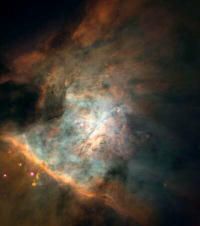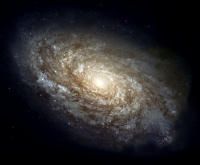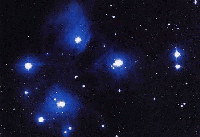Deep-Sky Objects
Deep-sky objects include multiple stars, variable stars, star clusters, nebulae and galaxies. A catalog of more than 100 deep-sky objects that you can see in a small telescope was compiled by Charles Messier in the 1700s. Messier objects are designated with a capital M followed by a number (e.g. M31, M41). They are often faint, fuzzy patches of light in any telescope. The key to observing most deep-sky objects is a dark sky (little or no light pollution) and a large telescope (greater than 6-inch or 15-cm aperture). However, some deep-sky objects can be seen in small telescopes like mine. Also, light pollution filters may help improve the view of some of these objects.
Multiple Stars
Many stars are actually arrangements of two or more stars that orbit each other. For example, if you look at Mizar (the middle star of the Big Dipper's handle) in a small telescope, you will see two stars. The same is true for Albireo (Beta Cygni). The stars that form the trapezium in the middle of the Orion Nebula (M42) are part of a four-star system. The stars in multiple star systems may be different sizes, brightnesses and colors. One challenge to an amateur astronomer is to "split" a multiple star system -- be able to resolve the star system into the individual stars using appropriate magnification.
Advertisement
Variable Stars
Some stars periodically brighten and dim as you observe them over time; these stars are called variable stars. Variable stars can include:
- eclipsing binary stars - one member star passes in front of the other (the star Algol in the constellation Perseus brightens and dims every few days)
- Cepheid variables - these stars change brightness due to changes in their interior
- long-period (Mira) variables - these stars change brightness over the course of months
- cataclysmic variables - these include explosive events such as novas and supernovas
Many variable stars can be observed with small telescopes, and their light intensities estimated by comparing them to stars of known magnitude. Variable star observing is one area in which amateurs can contribute greatly to the science of astronomy, because professional astronomers do not have the time necessary for such observations. See the American Association of Variable Star Observers (AAVSO) for details.
Star Clusters
Star clusters are close associations of thousands of stars or more. They can be open clusters or globular clusters. Star clusters offer spectacular views in a small telescope. One example is the Pleiades in the constellation Taurus (at right). The Pleiades has seven bright stars that can be seen with the naked eye; but when viewed in a small telescope like mine, many thousands jump out at you.

Nebulae
Nebulae are clouds of gas and dust in interstellar space. One of my favorite nebulae is the Great Nebula in the constellation Orion (M42). It is easily seen with the naked eye as Orion's sword. It has a large gas and dust cloud, with an inner triangle of stars called the Trapezium. I can see the gas, but not with the detail of the Hubble image shown here. No amateur telescope has that degree of detail. The Orion nebula is an emission nebula, in that it emits light, as opposed to an absorption or dark nebula, which absorbs light (e.g. Horsehead Nebula, also in Orion). Some nebulae, such as the Horsehead, are a real challenge to find and observe.
Nebulae are best viewed under low magnification, and rich-field telescopes can provide good views. Large aperture telescopes can gather enough light to produce bright images, and light pollution filters may help you to see details within nebulae, especially for urban/suburban astronomers. Nebulae are favorite targets for astrophotographers.
Galaxies
Galaxies are massive systems of stars held together by gravity. They can be alone, but are mostly found in clusters. One galaxy, the Andromeda galaxy (M31), can be seen with the naked eye. In the Southern Hemisphere, the Large and Small Magellanic Clouds are satellite galaxies that orbit our galaxy, the Milky Way. Galaxies come in many shapes and sizes:

- spiral (M31 in Andromeda)
- elliptical (M87 in Virgo)
- barred, spiral (NGC 1530 in Camelopardalis)
- irregular (the Magellanic Clouds, M82 in Ursa Major)
In a small telescope like mine, galaxies appear as faint, fuzzy patches. I can see M31 in Andromeda as an angled disc. To see fine detail in galaxies, including lanes of dust across them, you need a large aperture (8 to 10 inches or greater) telescope. Dark skies are essential for observing most galaxies. Like nebulae, galaxies are a favorite target for astrophotographers.
